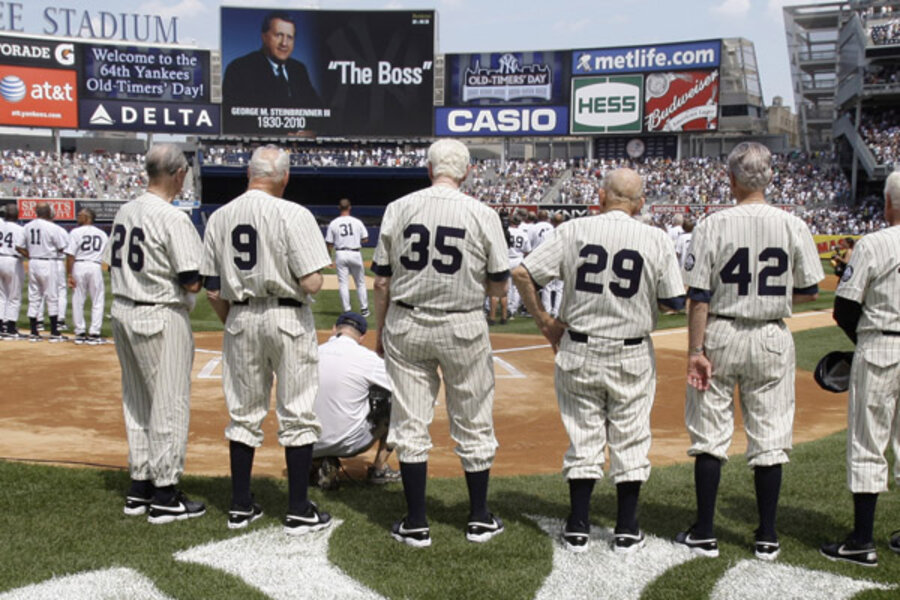An economist’s tribute to George Steinbrenner
Loading...
George Steinbrenner, owner of the New York Yankees for the past 37 years, died Tuesday at the age of 80. Steinbrenner may be best known for his antics as an overly hands-on owner during the 1970s and 1980s, his love hate relationship with manager Billy Martin, and his almost maniacal obsession with his former star player David Winfield; however, it is the way that he changed the economics of baseball that will have a lasting impact on the game.
Playing in the largest and richest metropolitan area in the country Steinbrenner began to realize that he could charge more for tickets and local broadcasting rights than his competitors. In addition, while professional sports franchises had long had cozy relationships with media companies, indeed Steinbrenner himself bought the Yankees from CBS in 1973, Steinbrenner made the Yankees one of the first American sports team to have direct control of its own television network with his creation of the Yankees Entertainment and Sports (YES) Network in 2002.
Of most importance to the game of baseball, however, was Steinbrenner’s willingness to use the proceeds of his business deals to buy the best talent, ushering in an era of “haves” and “have nots” in Major League Baseball. In 1991, the Yankee’s payroll of roughly $28 million was only slightly above the league average and less than the payrolls of such small market teams as the Kansas City Royals and Oakland A’s. Since that time, however, the Yankees have flexed their financial muscles and actively pursued the biggest, and highest paid, names in the game including guys like C.C. Sabathia, Mark Teixeira, and most notably, Alex Rodriguez. With an opening day lineup featuring the four highest paid players in the game, the 2010 Yankees have the highest payroll in Major League Baseball for the 12th consecutive season.
The arms race to keep up with Steinbrenner’s Yankees has led to an explosion in player salaries and a widening gulf between large-market and small-market teams. A-Rod’s $33 million salary this year would have exceeded any team’s entire payroll just two decades ago and four other Yankees will earn over $17 million in 2010 an amount equal to the average team payroll for the league in 1990.
Unfortunately, not every team in every city can compete with the deep pockets of the Yankees and their closest followers. While in the 1980s it was rare for the highest spending team to have a payroll more than 3 times that of the poorest team, today it is not unusual for the Yankees to outspend their poorest rivals by a multiple of 5 or 6 to 1, and in 2006 the Yankees outspent the hapless Florida Marlins by an astonishing 13 to 1.
And with money has come success. Since baseball expanded the playoffs in 1995, the Yankees have qualified for the postseason 14 of 15 years winning 5 World Series titles. Of course, over the time period many small-market teams have been left behind. For the likes of Pittsburgh, Milwaukee, and Kansas City the season is often over before it’s even begun since Steinbrenner opened up his wallet.
The combination of money and success has made the Yankees the team that America loves to hate. In the words of the late Chicago Tribune columnist Mike Royko, “Hating the Yankees is as American as pizza pie, unwed mothers, and cheating on your income tax,” and the same could be said of Steinbrenner. George Steinbrenner’s larger than life persona and free spending ways were endearing to some and rankled others, but love him or hate him, Steinbrenner has left a mark upon the game that will persist for years to come.
Add/view comments on this post.
------------------------------
The Christian Science Monitor has assembled a diverse group of the best economy-related bloggers out there. Our guest bloggers are not employed or directed by the Monitor and the views expressed are the bloggers' own, as is responsibility for the content of their blogs. To contact us about a blogger, click here. To add or view a comment on a guest blog, please go to the blogger's own site by clicking on the link above.





